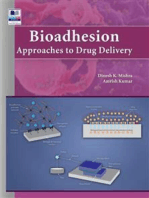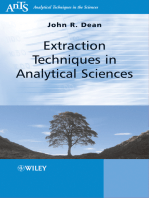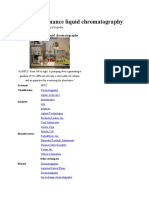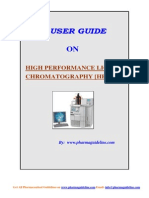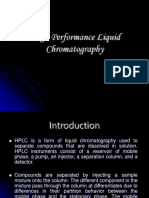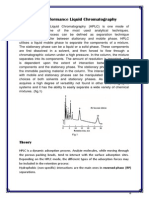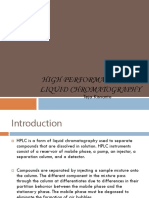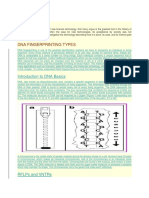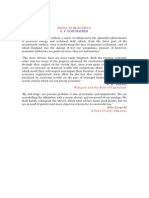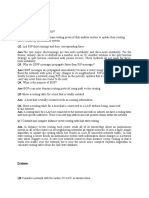RP HPLC
RP HPLC
Uploaded by
Goutam GhoshCopyright:
Available Formats
RP HPLC
RP HPLC
Uploaded by
Goutam GhoshOriginal Title
Copyright
Available Formats
Share this document
Did you find this document useful?
Is this content inappropriate?
Copyright:
Available Formats
RP HPLC
RP HPLC
Uploaded by
Goutam GhoshCopyright:
Available Formats
High-performance liquid chromatography - Wikipedia, the free encyclopedia
http://en.wikipedia.org/wiki/High-performance_liquid_chromatography#Reversed-phase_chrom...
High-performance liquid chromatography
From Wikipedia, the free encyclopedia
High-performance liquid chromatography (sometimes referred to as high-pressure liquid chromatography), HPLC, is a chromatographic technique used to separate a mixture of compounds in analytical chemistry and biochemistry with the purpose of identifying, quantifying and purifying the individual components of the mixture. Some common examples are the separation and quantitation of performance enhancement drugs (e.g. steroids) in urine samples, or of vitamin D levels in serum. HPLC typically utilizes different types of stationary phases (i.e. sorbents) contained in columns, a pump that moves the mobile phase and sample components through the column, and a detector capable of providing characteristic retention times for the sample components and area counts reflecting the amount of each analyte passing through the detector. The detector may also provide additional information related to the analyte, (i.e. UV/Vis spectroscopic data, if so equipped). Analyte retention time varies depending on the strength of its interactions with the stationary phase, the composition and flow rate of mobile phase used, and on the column dimensions. HPLC is a form of liquid chromatography that utilizes small size columns (typically 250 mm or shorter and 4.6 mm i.d. or smaller; packed with smaller particles), and higher mobile phase pressures compared to ordinary liquid chromatography. With HPLC, a pump (rather than gravity) provides the higher pressure required to move the mobile phase and sample components through the densely packed column. The increased density arises from the use of smaller sorbent particles. Such particles are capable of providing better separation on columns of shorter length when compared to ordinary column chromatography.
High-performance liquid chromatography
A HPLC. From left to right: A pumping device generating a gradient of two different solvents, a steel enforced column and an apparatus for measuring the absorbance. Acronym Classification Analytes HPLC Chromatography organic molecules biomolecules ions polymers
Contents
1 Operation 2 Types 2.1 Partition chromatography 2.2 Normal-phase chromatography 2.3 Displacement chromatography 2.4 Reversed-phase chromatography (RPC) 2.5 Size-exclusion chromatography 2.6 Ion-exchange chromatography 2.7 Bioaffinity chromatography 2.8 Aqueous normal-phase chromatography 3 Isocratic flow and gradient elution 4 Parameters 4.1 Internal diameter 4.2 Particle size
Other techniques Related Chromatography Aqueous Normal Phase Chromatography Hydrophilic Interaction Chromatography Ion exchange chromatography Size exclusion chromatography Micellar liquid chromatography Hyphenated Liquid chromatography-mass spectrometry
1 of 9
8/3/2012 2:05 PM
High-performance liquid chromatography - Wikipedia, the free encyclopedia
http://en.wikipedia.org/wiki/High-performance_liquid_chromatography#Reversed-phase_chrom...
4.3 Pore size 4.4 Pump pressure 5 See also 6 References 7 Further reading 8 External links
HPLC apparatus.
Operation
The sample to be separated and analyzed is introduced, in a discrete small volume, into the stream of mobile phase percolating through the column. The components of the sample move through the column at different velocities, which are functions of specific physical or chemical interactions with the stationary phase. The velocity of each component depends on its chemical nature, on the nature of the stationary phase (column) and on the composition of the mobile phase. The time at which a specific analyte elutes (emerges from the column) is called the retention time. The retention time measured under particular conditions is considered an identifying characteristic of a given analyte. The use of smaller particle size packing materials requires the use of higher operational pressure ("backpressure") and typically improves chromatographic resolution (i.e. the degree of separation between consecutive analytes emerging from the column). Common mobile phases used include any miscible combination of water with various organic solvents (the most common are acetonitrile and methanol). Some HPLC techniques use water free mobile phases (see Normal Phase HPLC below). The aqueous component of the mobile phase may contain buffers, acids (such as formic, phosphoric or trifluoroacetic acid) or salts to assist in the separation of the sample components. The composition of the mobile phase may be kept constant ("isocratic elution mode") or varied ("gradient elution mode") during the chromatographic analysis. Isocratic elution is typically effective in the separation of sample components that are not very dissimilar in their affinity for the stationary phase.
A modern self contained HPLC.
In gradient elution the composition of the mobile phase is varied typically from low to high eluting strength. The eluting strength of the mobile phase is reflected by analyte retention times with high eluting strength producing fast elution (=short retention times). A typical gradient profile in reversed phase chromatography might start at 5% acetonitrile (in water or aqueous buffer) and progress linearly to 95% acetonitrile over 525 minutes. Period of constant mobile phase composition may be part of any gradient profile. For example, the mobile phase composition may be kept constant at 5% acetonitrile for 13 min, followed by a linear change up to 95% acetonitrile. The composition of the mobile phase depends on the intensity of interactions between analytes and stationary phase (e.g. hydrophobic interactions in reversed-phase HPLC). Depending on their affinity for the stationary and mobile phases analytes partition between the two during the separation process taking place in the column. This partitioning process is similar to that which occurs during a liquid-liquid extraction but is continuous, not step-wise. In this example, using a water/acetonitrile gradient, more hydrophobic components will elute (come off the column) late, once the mobile phase gets more concentrated in acetonitrile (i.e. in a mobile phase of higher eluting strength). The choice of mobile phase components, additives (such as salts or acids) and gradient conditions depend on the nature of the column and sample components. Often a series of trial runs are performed with the sample in order to find the HPLC method which gives the best separation.
2 of 9
8/3/2012 2:05 PM
High-performance liquid chromatography - Wikipedia, the free encyclopedia
http://en.wikipedia.org/wiki/High-performance_liquid_chromatography#Reversed-phase_chrom...
Types
Partition chromatography
Partition chromatography was the first kind of chromatography that chemists developed. The partition coefficient principle has been applied in paper chromatography, thin layer chromatography, gas phase and liquid-liquid applications. The 1952 Nobel Prize in chemistry was earned by Archer John Porter Martin and Richard Laurence Millington Synge for their development of the technique, which was used for their separation of amino acids. Partition chromatography uses a retained solvent, on the surface or within the grains or fibers of an "inert" solid supporting matrix as with paper chromatography; or takes advantage of some coulombic and/or hydrogen donor interaction with the solid support. Molecules equilibrate (partition) between a liquid stationary phase and the eluent. Known as Hydrophilic Interaction Chromatography (HILIC) in HPLC, this method separates analytes based on polar differences. HILIC most often uses a bonded polar stationary phase and water miscible, high organic concentration, mobile phases. Partition HPLC has been used historically on unbonded silica or alumina supports. Each works effectively for separating analytes by relative polar differences. HILIC bonded phases have the advantage of separating acidic, basic and neutral solutes in a single chromatogram.[1] The polar analytes diffuse into a stationary water layer associated with the polar stationary phase and are thus retained. Retention strengths increase with increased analyte polarity, and the interaction between the polar analyte and the polar stationary phase (relative to the mobile phase) increases the elution time. The interaction strength depends on the functional groups in the analyte molecule which promote partitioning but can also include coulombic (electrostatic) interaction and hydrogen donor capability. Use of more polar solvents in the mobile phase will decrease the retention time of the analytes, whereas more hydrophobic solvents tend to increase retention times.
HILIC Partition Technique Useful Range
Normal-phase chromatography
It was one of the first kinds of HPLC that chemists developed. Also known as normal-phase HPLC (NP-HPLC), or adsorption chromatography, this method separates analytes based on their affinity for a polar stationary surface such as silica, hence it is based on analyte ability to engage in polar interactions (such as hydrogenbonding or dipole-dipole type of interactions) with the sorbent surface. NP-HPLC uses a non-polar, non-aqueous mobile phase, and works effectively for separating analytes readily soluble in non-polar solvents. The analyte associates with and is retained by the polar stationary phase. Adsorption strengths increase with increased analyte polarity. The interaction strength depends not only on the functional groups present in the structure of the analyte molecule, but also on steric factors. The affect of steric hindrance on interaction strength allows this method to resolve (separate) structural isomers. The use of more polar solvents in the mobile phase will decrease the retention time of analytes, whereas more hydrophobic solvents tend to induce slower elution (increased retention times). Very polar solvents such as traces of water in the mobile phase tend to adsorb to the solid surface of the stationary phase forming a stationary bound (water) layer which is considered to play an active role in retention. This behavior is somewhat peculiar to normal phase chromatograhy because it is governed almost exclusively by an adsorptive mechanism (i.e. analytes interact with a solid surface rather than with the solvated layer of a ligand attached to the sorbent surface; see also reversed-phase HPLC below). Adsorption chromatography is still widely used for structural isomer separations in both column and thin-layer chromatography formats on activated (dried) silica or alumina supports. Partition- and NP-HPLC fell out of favor in the 1970s with the development of reversed-phase HPLC because of poor reproducibility of retention times due to the presence of a water or protic organic solvent layer on the surface of the silica or alumina chromatographic media. This layer changes with any changes in the
3 of 9
8/3/2012 2:05 PM
High-performance liquid chromatography - Wikipedia, the free encyclopedia
http://en.wikipedia.org/wiki/High-performance_liquid_chromatography#Reversed-phase_chrom...
composition of the mobile phase (e.g. moisture level) causing drifting retention times. Recently, partition chromatography has become popular again with the development of HILIC bonded phases which demonstrate improved reproducibility, and due to a better understanding of the range of usefulness of the technique.
Displacement chromatography
The basic principle of displacement chromatography is: A molecule with a high affinity for the chromatography matrix (the displacer) will compete effectively for binding sites, and thus displace all molecules with lesser affinities.[2] There are distinct differences between displacement and elution chromatography. In elution mode, substances typically emerge from a column in narrow, Gaussian peaks. Wide separation of peaks, preferably to baseline, is desired in order to achieve maximum purification. The speed at which any component of a mixture travels down the column in elution mode depends on many factors. But for two substances to travel at different speeds, and thereby be resolved, there must be substantial differences in some interaction between the biomolecules and the chromatography matrix. Operating parameters are adjusted to maximize the effect of this difference. In many cases, baseline separation of the peaks can be achieved only with gradient elution and low column loadings. Thus, two drawbacks to elution mode chromatography, especially at the preparative scale, are operational complexity, due to gradient solvent pumping, and low throughput, due to low column loadings. Displacement chromatography has advantages over elution chromatography in that components are resolved into consecutive zones of pure substances rather than peaks. Because the process takes advantage of the nonlinearity of the isotherms, a larger column feed can be separated on a given column with the purified components recovered at significantly higher concentrations.
Reversed-phase chromatography (RPC)
For more details on this topic, see Reversed-phase chromatography. Reversed phase HPLC (RP-HPLC) has a non-polar stationary phase and an aqueous, moderately polar mobile phase. One common stationary phase is a silica which has been surface-modified with RMe2SiCl, where R is a straight chain alkyl group such as C18H37 or C8H17. With such stationary phases, retention time is longer for molecules which are less polar, while polar molecules elute more readily (early in the analysis). An investigator can increase retention times by adding more water to the mobile phase; thereby making the affinity of the hydrophobic analyte for the hydrophobic stationary phase stronger relative to the now more hydrophilic mobile phase. Similarly, an investigator can decrease retention time by adding more organic solvent to the eluent. RP-HPLC is so commonly used that it is often incorrectly referred to as "HPLC" without further specification. The pharmaceutical industry regularly employs RP-HPLC to qualify drugs before their release.
A chromatogram of complex mixture (perfume
RP-HPLC operates on the principle of hydrophobic interactions, which originate from the high symmetry in the water) obtained by reversed phase HPLC dipolar water structure and play the most important role in all processes in life science. RP-HPLC allows the measurement of these interactive forces. The binding of the analyte to the stationary phase is proportional to the contact surface area around the non-polar segment of the analyte molecule upon association with the ligand on the stationary phase. This solvophobic effect is dominated by the force of water for "cavity-reduction" around the analyte and the C18-chain versus the complex of both. The energy released in this process is proportional to the surface tension of the eluent (water: 7.3 106 J/cm, methanol: 2.2 106 J/cm) and to the hydrophobic surface of the analyte and the ligand respectively. The retention can be decreased by adding a less polar solvent (methanol, acetonitrile) into the mobile phase to reduce the surface tension of water. Gradient elution uses this effect by automatically reducing the polarity and the surface tension of the aqueous mobile phase during the course of the analysis.
4 of 9
8/3/2012 2:05 PM
High-performance liquid chromatography - Wikipedia, the free encyclopedia
http://en.wikipedia.org/wiki/High-performance_liquid_chromatography#Reversed-phase_chrom...
Structural properties of the analyte molecule play an important role in its retention characteristics. In general, an analyte with a larger hydrophobic surface area (C-H, C-C, and generally non-polar atomic bonds, such as S-S and others) is retained longer because it is non-interacting with the water structure. On the other hand, analytes with higher polar surface area (conferred by the presence of polar groups, such as -OH, -NH2, COO or -NH3+ in their structure)are less retained as they are better integrated into water. Such interactions are subject to steric effects in that very large molecules may have only restricted access to the pores of the stationary phase, where the interactions with surface ligands (alkyl chains) take place. Such surface hindrance typically results in less retention. Retention time increases with hydrophobic (non-polar) surface area. Branched chain compounds elute more rapidly than their corresponding linear isomers because the overall surface area is decreased. Similarly organic compounds with single C-C-bonds elute later than those with a C=C or C-C-triple bond, as the double or triple bond is shorter than a single C-C-bond. Aside from mobile phase surface tension (organizational strength in eluent structure), other mobile phase modifiers can affect analyte retention. For example, the addition of inorganic salts causes a moderate linear increase in the surface tension of aqueous solutions (ca. 1.5 107 J/cm per Mol for NaCl, 2.5 107 J/cm per Mol for (NH4)2SO4), and because the entropy of the analyte-solvent interface is controlled by surface tension, the addition of salts tend to increase the retention time. This technique is used for mild separation and recovery of proteins and protection of their biological activity in protein analysis (hydrophobic interaction chromatography, HIC). Another important factor is the mobile phase pH since it can change the hydrophobic character of the analyte. For this reason most methods use a buffering agent, such as sodium phosphate, to control the pH. Buffers serve multiple purposes: control of pH, neutralize the charge on the silica surface of the stationary phase and act as ion pairing agents to neutralize analyte charge. Ammonium formate is commonly added in mass spectrometry to improve detection of certain analytes by the formation of analyte-ammonium adducts. A volatile organic acid such as acetic acid, or most commonly formic acid, is often added to the mobile phase if mass spectrometry is used to analyze the column effluent. Trifluoroacetic acid is used infrequently in mass spectrometry applications due to its persistence in the detector and solvent delivery system, but can be effective in improving retention of analytes such as carboxylic acids in applications utilizing other detectors, as it is a fairly strong organic acid. The effects of acids and buffers vary by application but generally improve chromatographic resolution. Reversed phase columns are quite difficult to damage compared with normal silica columns; however, many reversed phase columns consist of alkyl derivatized silica particles and should never be used with aqueous bases as these will destroy the underlying silica particle. They can be used with aqueous acid, but the column should not be exposed to the acid for too long, as it can corrode the metal parts of the HPLC equipment. RP-HPLC columns should be flushed with clean solvent after use to remove residual acids or buffers, and stored in an appropriate composition of solvent. The metal content of HPLC columns must be kept low if the best possible ability to separate substances is to be retained. A good test for the metal content of a column is to inject a sample which is a mixture of 2,2'- and 4,4'- bipyridine. Because the 2,2'-bipy can chelate the metal, the shape of the peak for the 2,2'-bipy will be distorted (tailed) when metal ions are present on the surface of the silica.[citation needed]..
Size-exclusion chromatography
For more details on this topic, see size-exclusion chromatography. Size-exclusion chromatography (SEC), also known as gel permeation chromatography or gel filtration chromatography, separates particles on the basis of size. It is generally a low resolution chromatography and thus it is often reserved for the final, "polishing" step of a purification. It is also useful for determining the tertiary structure and quaternary structure of purified proteins. SEC is used primarily for the analysis of large molecules such as proteins or polymers. SEC works by trapping these smaller molecules in the pores of a particle. The larger molecules simply pass by the pores as they are too large to enter the pores. Larger molecules therefore flow through the column quicker than smaller molecules, that is, the smaller the molecule, the longer the retention time. This technique is widely used for the molecular weight determination of polysaccharides. SEC is the official technique (suggested by European pharmacopeia) for the
5 of 9
8/3/2012 2:05 PM
High-performance liquid chromatography - Wikipedia, the free encyclopedia
http://en.wikipedia.org/wiki/High-performance_liquid_chromatography#Reversed-phase_chrom...
molecular weight comparison of different commercially available low-molecular weight heparins.
Ion-exchange chromatography
For more details on this topic, see Ion-exchange chromatography. In ion-exchange chromatography (IC), retention is based on the attraction between solute ions and charged sites bound to the stationary phase. Ions of the same charge are excluded. Types of ion exchangers include: Polystyrene resins These allow cross linkage which increases the stability of the chain. Higher cross linkage reduces swerving, which increases the equilibration time and ultimately improves selectivity. Cellulose and dextran ion exchangers (gels) These possess larger pore sizes and low charge densities making them suitable for protein separation. Controlled-pore glass or porous silica In general, ion exchangers favor the binding of ions of higher charge and smaller radius. An increase in counter ion (with respect to the functional groups in resins) concentration reduces the retention time. A decrease in pH reduces the retention time in cation exchange while an increase in pH reduces the retention time in anion exchange. By lowering the pH of the solvent in a cation exchange column, for instance, more hydrogen ions are available to compete for positions on the anionic stationary phase, thereby eluting weakly bound cations. This form of chromatography is widely used in the following applications: water purification, preconcentration of trace components, ligand-exchange chromatography, ion-exchange chromatography of proteins, high-pH anion-exchange chromatography of carbohydrates and oligosaccharides, and others.
Bioaffinity chromatography
This chromatographic process relies on the property of biologically active substances to form stable, specific, and reversible complexes. The formation of these complexes involves the participation of common molecular forces such as the Van der Waals interaction, electrostatic interaction, dipole-dipole interaction, hydrophobic interaction, and the hydrogen bond. An efficient, biospecific bond is formed by a simultaneous and concerted action of several of these forces in the complementary binding sites.
Aqueous normal-phase chromatography
Aqueous normal-phase chromatography (ANP) is a chromatographic technique which encompasses the mobile phase region between reversed-phase chromatography (RP) and organic normal phase chromatography (ONP). This technique is used to achieve unique selectivity for hydrophilic compounds, showing normal phase elution using reverse-phase solvents.[citation needed]
Isocratic flow and gradient elution
A separation in which the mobile phase composition remains constant throughout the procedure is termed isocratic (meaning constant composition). The word was coined by Csaba Horvath who was one of the pioneers of HPLC.[citation needed],
6 of 9
8/3/2012 2:05 PM
High-performance liquid chromatography - Wikipedia, the free encyclopedia
http://en.wikipedia.org/wiki/High-performance_liquid_chromatography#Reversed-phase_chrom...
The mobile phase composition does not have to remain constant. A separation in which the mobile phase composition is changed during the separation process is described as a gradient elution.[3] One example is a gradient starting at 10% methanol and ending at 90% methanol after 20 minutes. The two components of the mobile phase are typically termed "A" and "B"; A is the "weak" solvent which allows the solute to elute only slowly, while B is the "strong" solvent which rapidly elutes the solutes from the column. In reverse-phase chromatography, solvent A is often water or an aqueous buffer, while B is an organic solvent miscible with water, such as acetonitrile, methanol, THF, or isopropanol. In isocratic elution, peak width increases with retention time linearly according to the equation for N, the number of theoretical plates. This leads to the disadvantage that late-eluting peaks get very flat and broad. Their shape and width may keep them from being recognized as peaks. Gradient elution decreases the retention of the later-eluting components so that they elute faster, giving narrower (and taller) peaks for most components. This also improves the peak shape for tailed peaks, as the increasing concentration of the organic eluent pushes the tailing part of a peak forward. This also increases the peak height (the peak looks "sharper"), which is important in trace analysis. The gradient program may include sudden "step" increases in the percentage of the organic component, or different slopes at different times all according to the desire for optimum separation in minimum time. In isocratic elution, the selectivity does not change if the column dimensions (length and inner diameter) change that is, the peaks elute in the same order. In gradient elution, the elution order may change as the dimensions or flow rate change.[citation needed] The driving force in reversed phase chromatography originates in the high order of the water structure. The role of the organic component of the mobile phase is to reduce this high order and thus reduce the retarding strength of the aqueous component.
Parameters
Internal diameter
The internal diameter (ID) of an HPLC column is an important parameter that influences the detection sensitivity and separation selectivity in gradient elution. It also determines the quantity of analyte that can be loaded onto the column. Larger columns are usually seen in industrial applications, such as the purification of a drug product for later use. Low-ID columns have improved sensitivity and lower solvent consumption at the expense of loading capacity. Larger ID columns (over 10 mm) are used to purify usable amounts of material because of their large loading capacity. Analytical scale columns (4.6 mm) have been the most common type of columns, though smaller columns are rapidly gaining in popularity. They are used in traditional quantitative analysis of samples and often use a UV-Vis absorbance detector. Narrow-bore columns (12 mm) are used for applications when more sensitivity is desired either with special UV-vis detectors, fluorescence detection or with other detection methods like liquid chromatography-mass spectrometry Capillary columns (under 0.3 mm) are used almost exclusively with alternative detection means such as mass spectrometry. They are usually made from fused silica capillaries, rather than the stainless steel tubing that larger columns employ.
Particle size
Most traditional HPLC is performed with the stationary phase attached to the outside of small spherical silica particles (very small beads). These particles come in a variety of sizes with 5 m beads being the most common. Smaller particles generally provide more surface area and better separations, but the pressure required for optimum linear velocity increases by the inverse of the particle diameter squared.[4][5][6]
7 of 9
8/3/2012 2:05 PM
High-performance liquid chromatography - Wikipedia, the free encyclopedia
http://en.wikipedia.org/wiki/High-performance_liquid_chromatography#Reversed-phase_chrom...
This means that changing to particles that are half as big, keeping the size of the column the same, will double the performance, but increase the required pressure by a factor of four. Larger particles are used in preparative HPLC (column diameters 5 cm up to >30 cm) and for non-HPLC applications such as solid-phase extraction.
Pore size
Many stationary phases are porous to provide greater surface area. Small pores provide greater surface area while larger pore size has better kinetics, especially for larger analytes. For example, a protein which is only slightly smaller than a pore might enter the pore but does not easily leave once inside.
Pump pressure
Pumps vary in pressure capacity, but their performance is measured on their ability to yield a consistent and reproducible flow rate. Pressure may reach as high as 40 MPa (6000 lbf/in2), or about 400 atmospheres. Modern HPLC systems have been improved to work at much higher pressures, and therefore are able to use much smaller particle sizes in the columns (<2 m). These "Ultra High Performance Liquid Chromatography" systems or RSLC/UHPLCs can work at up to 100 MPa (15,000 lbf/in), or about 1000 atmospheres. The term "UPLC" is a trademark of the Waters Corporation, but is sometimes used to refer to the more general technique.
See also
Csaba Horvth Ion chromatography Column Chromatography
References
1. ^ Lindsay, S. ; Kealey, D. (1987). High performance liquid chromatography (http://www.osti.gov/energycitations/product.biblio.jsp?osti_id=7013902) . Wiley. http://www.osti.gov/energycitations/product.biblio.jsp?osti_id=7013902. from review Hung, L. B.; Parcher, J. F.; Shores, J. C.; Ward, E. H. (1988). "Theoretical and experimental foundation for surface-coverage programming in gas-solid chromatography with an adsorbable carrier gas". J. Am. Chem. Soc. 110 (11): 1090. doi:10.1021/ac00162a003 (http://dx.doi.org/10.1021%2Fac00162a003) . 2. ^ Displacement Chromatography (http://www.sacheminc.com/industries/biotechnology/teaching-tools.html) . Sacheminc.com. Retrieved on 2011-06-07. 3. ^ A recent book provides a comprehensive treatment of the theory of high-performance gradient chromatography: Lloyd R. Snyder and John W. Dolan (2006). High-Performance Gradient Elution: The Practical Application of the Linear-Solvent-Strength Model. Wiley Interscience. ISBN 0-471-70646-9. 4. ^ Majors, Ronald E.. (2010-09-07) Fast and Ultrafast HPLC on sub-2 m Porous Particles Where Do We Go From Here? LC-GC Europe (http://www.lcgceurope.com /lcgceurope/article/articleDetail.jsp?id=333246&pageID=3#) . Lcgceurope.com. Retrieved on 2011-06-07. 5. ^ Xiang, Y.; Liu Y. and Lee M.L. (2006). "Ultrahigh pressure liquid chromatography using elevated temperature". Journal of Chromatography A 1104 (12): 198202. doi:10.1016/j.chroma.2005.11.118 (http://dx.doi.org/10.1016%2Fj.chroma.2005.11.118) . PMID 16376355 (//www.ncbi.nlm.nih.gov/pubmed/16376355) . 6. ^ Horvth, Cs.; Preiss B.A. and Lipsky S.R. (1967). "Fast liquid chromatography. Investigation of operating parameters and the separation of nucleotides on pellicular ion exchangers". Analytical Chemistry 39 (12): 14221428. doi:10.1021/ac60256a003 (http://dx.doi.org/10.1021%2Fac60256a003) . PMID 6073805 (//www.ncbi.nlm.nih.gov /pubmed/6073805) .
Further reading
L. R. Snyder, J.J. Kirkland, and J. W. Dolan, Introduction to Modern Liquid Chromatography, John Wiley & Sons, New York, 2009.
8 of 9
8/3/2012 2:05 PM
High-performance liquid chromatography - Wikipedia, the free encyclopedia
http://en.wikipedia.org/wiki/High-performance_liquid_chromatography#Reversed-phase_chrom...
M.W. Dong, Modern HPLC for practicing scientists. Wiley, 2006. L. R. Snyder, J.J. Kirkland, and J. L. Glajch, Practical HPLC Method Development, John Wiley & Sons, New York, 1997. S. Ahuja and H. T. Rasmussen (ed), HPLC Method Development for Pharmaceuticals, Academic Press, 2007. S. Ahuja and M.W. Dong (ed), Handbook of Pharmaceutical Analysis by HPLC, Elsevier/Academic Press, 2005. Y. V. Kazakevich and R. LoBrutto (ed.), HPLC for Pharmaceutical Scientists, Wiley, 2007. U. D. Neue, HPLC Columns: Theory, Technology, and Practice, Wiley-VCH, New York, 1997.
External links
Liquid Chromatography (http://www.dmoz.org//Science/Chemistry/Analytical/Separations_Science/Liquid_Chromatography/) at the Open Directory Project Retrieved from "http://en.wikipedia.org/w/index.php?title=High-performance_liquid_chromatography&oldid=505356151" Categories: Chromatography Scientific techniques This page was last modified on 2 August 2012 at 01:32. Text is available under the Creative Commons Attribution-ShareAlike License; additional terms may apply. See Terms of use for details. Wikipedia is a registered trademark of the Wikimedia Foundation, Inc., a non-profit organization.
9 of 9
8/3/2012 2:05 PM
You might also like
- A Laboratory Manual of Physical PharmaceuticsFrom EverandA Laboratory Manual of Physical PharmaceuticsRating: 2.5 out of 5 stars2.5/5 (2)
- Air Contaminants and Industrial Hygiene VentilationDocument236 pagesAir Contaminants and Industrial Hygiene Ventilationmilanstr100% (3)
- Sample Preparation in LC-MS BioanalysisFrom EverandSample Preparation in LC-MS BioanalysisWenkui LiNo ratings yet
- Liquid Chromatography - Mass Spectrometry: An IntroductionFrom EverandLiquid Chromatography - Mass Spectrometry: An IntroductionNo ratings yet
- Current Good Manufacturing Practices (cGMP) for Pharmaceutical ProductsFrom EverandCurrent Good Manufacturing Practices (cGMP) for Pharmaceutical ProductsNo ratings yet
- Advanced Pharmaceutical analysisFrom EverandAdvanced Pharmaceutical analysisRating: 4.5 out of 5 stars4.5/5 (2)
- Development of Sustainable Bioprocesses: Modeling and AssessmentFrom EverandDevelopment of Sustainable Bioprocesses: Modeling and AssessmentNo ratings yet
- Columns for Gas Chromatography: Performance and SelectionFrom EverandColumns for Gas Chromatography: Performance and SelectionNo ratings yet
- Comprehensive Quality by Design for Pharmaceutical Product Development and ManufactureFrom EverandComprehensive Quality by Design for Pharmaceutical Product Development and ManufactureGintaras V. ReklaitisNo ratings yet
- Exercises in Organic Synthesis Based on Synthetic DrugsFrom EverandExercises in Organic Synthesis Based on Synthetic DrugsNo ratings yet
- High-Performance Gradient Elution: The Practical Application of the Linear-Solvent-Strength ModelFrom EverandHigh-Performance Gradient Elution: The Practical Application of the Linear-Solvent-Strength ModelNo ratings yet
- HPLCDocument9 pagesHPLCEssar MuhthaniNo ratings yet
- High-Performance Liquid ChromatographyDocument17 pagesHigh-Performance Liquid ChromatographyRia TalukdaarNo ratings yet
- High-Performance Liquid Chromatography (HPLC Formerly Referred ToDocument21 pagesHigh-Performance Liquid Chromatography (HPLC Formerly Referred ToKhagesh JoshNo ratings yet
- HPLCDocument22 pagesHPLCKafi Mahmood NahinNo ratings yet
- A User Guide: High Performance Liquid Chromatography (HPLC)Document54 pagesA User Guide: High Performance Liquid Chromatography (HPLC)Marcelinus AlfasisuryaNo ratings yet
- Makerere University College of Health Sciences Department of Pharmacology Pharmacology Report DATE: 24/4/17Document10 pagesMakerere University College of Health Sciences Department of Pharmacology Pharmacology Report DATE: 24/4/17mug ashNo ratings yet
- HPLC User GuideDocument54 pagesHPLC User GuidesdrtfgNo ratings yet
- High Performance Liquid ChromatographyDocument45 pagesHigh Performance Liquid ChromatographyAditya MahakalNo ratings yet
- A User Guide HPLCDocument54 pagesA User Guide HPLCjeyapragash RamadassNo ratings yet
- HPLCDocument8 pagesHPLCShaffan MohdNo ratings yet
- HPLC IllustratedDocument33 pagesHPLC Illustratedatiyorockfan9017No ratings yet
- High Performance Liquid ChromatographyDocument15 pagesHigh Performance Liquid ChromatographyFaran Faseesa Ismail0% (1)
- HPLCDocument21 pagesHPLCAli Imran KhawajaNo ratings yet
- High Performance Liquid Chromatography (HPLC) : Presenter: Nandit P BDocument39 pagesHigh Performance Liquid Chromatography (HPLC) : Presenter: Nandit P BNandit BanawalikarNo ratings yet
- Types of HPLC: Ion-Exchange ChromatographyDocument2 pagesTypes of HPLC: Ion-Exchange ChromatographyMuhammad SalmanNo ratings yet
- HPLC LectureDocument17 pagesHPLC LectureMani JeeNo ratings yet
- HPLCDocument4 pagesHPLCAlbert BohrNo ratings yet
- Determination of Trichloroacetic Acid Using HPLCDocument11 pagesDetermination of Trichloroacetic Acid Using HPLCLucia PuspitasariNo ratings yet
- High Performance Liquid ChromatographyDocument28 pagesHigh Performance Liquid ChromatographyNur Asiah0% (1)
- High Performance Liquid ChromatographyDocument11 pagesHigh Performance Liquid ChromatographyPrincess AleenaNo ratings yet
- High Performance Liquid Chromatography VERY GOODDocument22 pagesHigh Performance Liquid Chromatography VERY GOODDewi SeptianiNo ratings yet
- Lite TP Gas ChromatographyDocument5 pagesLite TP Gas ChromatographyAntonio FrianNo ratings yet
- Oltp VS OlapDocument9 pagesOltp VS OlapSikkandar Sha100% (1)
- MT7 SolutionDocument3 pagesMT7 SolutionApril Bacaser DancilNo ratings yet
- Od 431651618644941100Document2 pagesOd 431651618644941100g90477094No ratings yet
- Naming WordsDocument3 pagesNaming Wordsletlen.sanpascual1No ratings yet
- Be - Artificial Intelligence and Data Science - Semester 7 - 2023 - October - Data Modeling & Visualization DM & V 2019 PatternDocument2 pagesBe - Artificial Intelligence and Data Science - Semester 7 - 2023 - October - Data Modeling & Visualization DM & V 2019 Patternshubham02ytNo ratings yet
- Esd 4Document40 pagesEsd 40442- TARUNNo ratings yet
- 6th Grade Summary First ExamDocument5 pages6th Grade Summary First Examteeba.diabat77No ratings yet
- 量子计算机的研究Document6 pages量子计算机的研究William WangNo ratings yet
- Sociology SyllabusDocument23 pagesSociology SyllabusSophia MK100% (1)
- Lesson 3 Social LifeDocument9 pagesLesson 3 Social LifeMaribel FelicenNo ratings yet
- Blueprint XXV Web PDFDocument184 pagesBlueprint XXV Web PDFTiko VegaNo ratings yet
- Project Proposal Loadi Ka-Em: Psem VSC Load Subsidy ProgramDocument6 pagesProject Proposal Loadi Ka-Em: Psem VSC Load Subsidy ProgramJames BastatasNo ratings yet
- Introduction To DNA BasicsDocument8 pagesIntroduction To DNA BasicsSãchïñ ChôūdhåryNo ratings yet
- Discrete Mathematical StructuresDocument2 pagesDiscrete Mathematical Structuresmundando networksNo ratings yet
- BCA SyllabusDocument50 pagesBCA SyllabusKoustav DasNo ratings yet
- Atoms, Elements and Compounds g7Document40 pagesAtoms, Elements and Compounds g7Menaga A/P IlangkovanNo ratings yet
- Maths Mid Term II (2018-2019)Document5 pagesMaths Mid Term II (2018-2019)kushal agarwalNo ratings yet
- MangaDocument73 pagesMangaRita BrandãoNo ratings yet
- OMC Roller Catalog PDFDocument77 pagesOMC Roller Catalog PDFMarco ViniciusNo ratings yet
- Small Is Beautiful - E F SchumacherDocument176 pagesSmall Is Beautiful - E F SchumachervempsNo ratings yet
- Pe QuizDocument9 pagesPe QuizRobert ColomaNo ratings yet
- Counselors of Real Estate Summary Report For SAISDDocument79 pagesCounselors of Real Estate Summary Report For SAISDMason100% (1)
- Kouimsk 2016Document11 pagesKouimsk 2016Panji Wira ManggalaNo ratings yet
- Nissan Truck d21 Service Manual 97Document20 pagesNissan Truck d21 Service Manual 97denise100% (45)
- Prescribing For Pediatric Patients Leat 2011 ResaltadoDocument14 pagesPrescribing For Pediatric Patients Leat 2011 ResaltadoGil GopNo ratings yet
- SAMPLE PAPER-II Class XII (Computer Science) QP With MS & BPDocument16 pagesSAMPLE PAPER-II Class XII (Computer Science) QP With MS & BPSUPSNDI SINGHNo ratings yet
- ERP in HealthcareDocument11 pagesERP in HealthcareAshik HaqueNo ratings yet
- Routing Protocol by Sharad SirDocument2 pagesRouting Protocol by Sharad Sirshahaban ali0% (1)
- Biology 6th Grade (English)Document221 pagesBiology 6th Grade (English)mohaxm1324No ratings yet


























